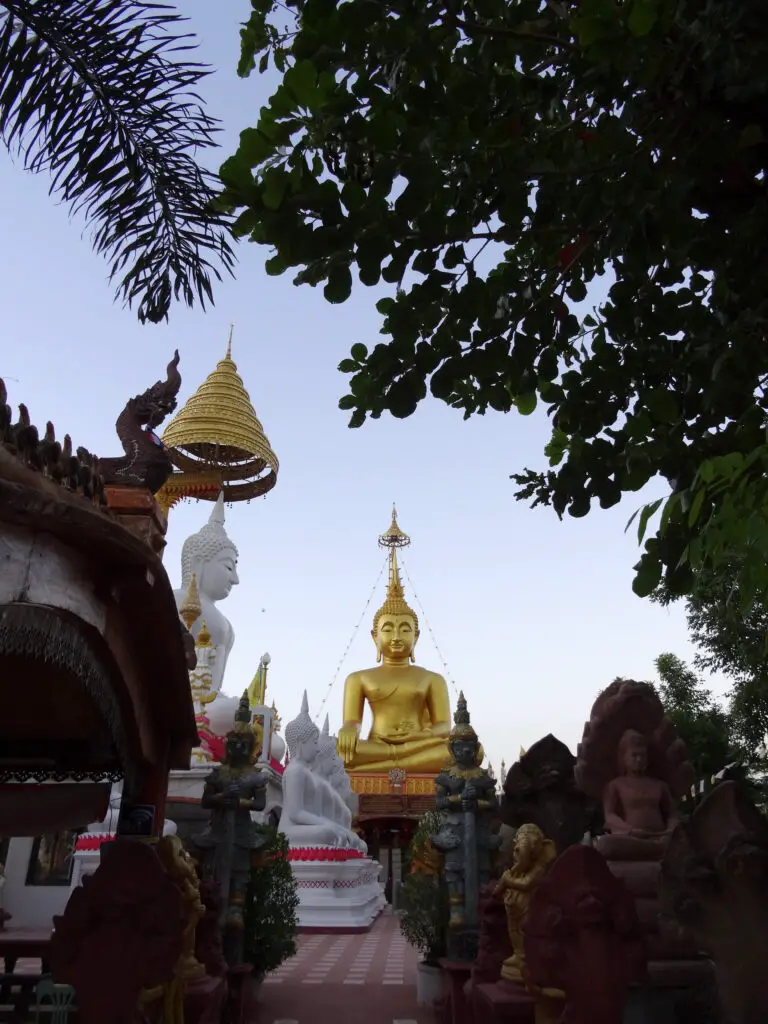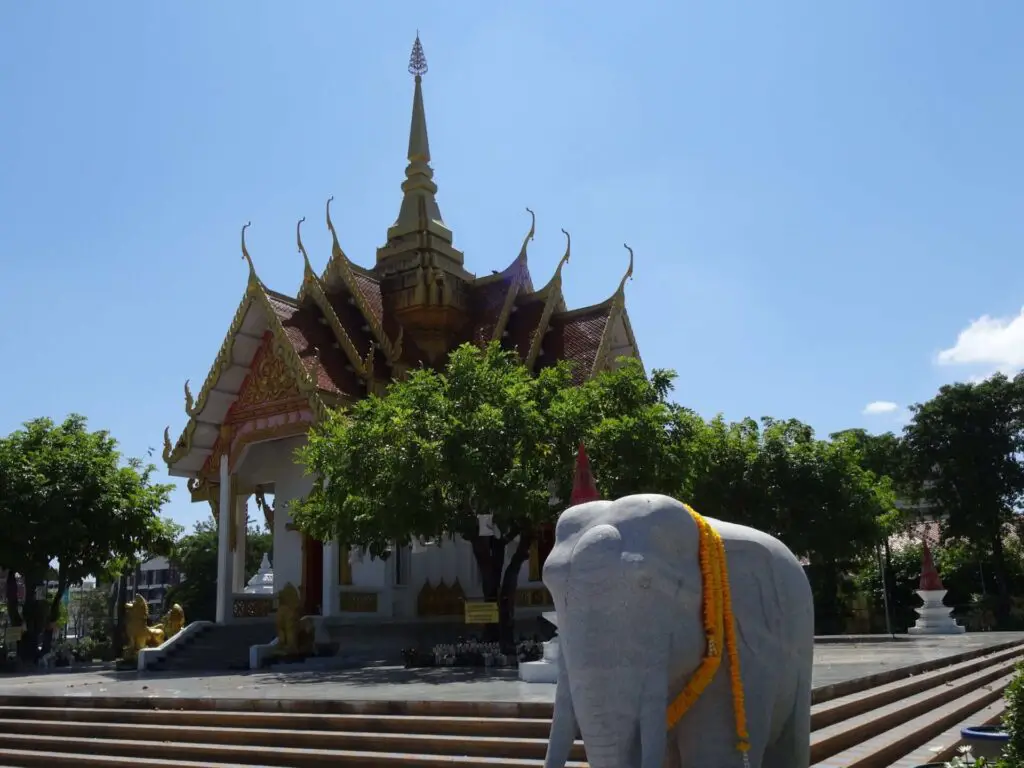Ubon Ratchathani (translating to ‘Royal Lotus City’) is a pleasant city in the south-eastern Isan Region, far off Thailand’s tourist circuit. Those who make it to this sleepy corner of the country are rewarded with a pretty townscape dominated by the Mae Nam Mun River, idyllic parks and some unusual temples.
Originally, I only meant to stop here to connect to Pha Thaem National Park, but I was struck by the city’s charm and decided to stay a couple of days to soak up the atmosphere. If you decide to do the same, read on for my suggestions of the best things to Do in Ubon Ratchathani.
This post may contain affiliate links, and I might earn a small commission at no additional cost to you. For more info, click here.
The Best Things to See and Do in Ubon Ratchathani
I’ve ordered the following sights by how worth-while and interesting I found them. The first two temples are a bit outside the centre, but definitely worth the detour.
Wat Phra That Nong Bua
Wat Phra That Nong Bua may have only been built in the 1950s, but what it lacks in age it makes up in beauty. For me, this is one of the most spectacular temples in the Isan Region. The striking central stupa is surrounded by a beautifully manicured garden and houses another, smaller stupa in its intricately decorated interior.


Every surface of the chedi and its surrounding features it either blindingly white or covered in gilded arabesques – it’s certainly a sight to behold.
The temple is located in the vicinity of the bus station, about 5km north-west of the centre to the west of Thanon Chayangkun. Songthaews going to the bus station (line 1, 3, 10 and 11 at the time of writing) can drop you near the temple.
Wat Ban Na Meuang
Sometimes also referred to as Wat Sa Prasan Suk, this unusual temple sits a few kilometres north of the city centre. The most interesting feature is the wihan (assembly hall), which is shaped like a boat and sits on a small pond.

The ubosot (ordination hall), is similarly boat-shaped and even comes with a set of rowers. There’s also a small bell-tower that you can climb. The temple is located to the north of the airport – you can get there by songthaew or motorcycle taxi.
Wat Tai Phra Chao Yai Ong Tue
The grounds of this temple at the southeastern end of the city centre are chock-full of Buddha statues and other religious imagery. It’s a somewhat surreal place, and I enjoyed strolling through the sometimes inconsistent-seeming groupings of statues in very different styles.


I also had a lengthy conversation with one of the monks, who was very determined to convince me to don some monk’s robes myself, although I ultimately managed to convince him that I’m more of the itinerant type.
Thung Si Meuang Park
The pretty city park isn’t only a nice place for a stroll, but also home to some historical monuments. Most interesting among the latter is the gilded statue in the centre of the park, which is commemorating Ubon’s yearly Candle Float Parade.


Other statues can be found on the corners of the moat surrounding the park plus in the north-eastern part is the unassuming Monument of Merit, donated by former British POW’s, who were detained in the city by the Japanese occupying forces during WW2. The park is located a few blocks north of the river along Thanon Upparat.
Wat Thung Si Meuang
This 19th century temple is most famous for its well-preserved murals in the small Ubosot (ordniation hall), but I particularly liked the intricately carved Ho Trai (library building). It’s constructed on stilts and stands in a small pond, to protect the precious contents from termites and the like.


The Wat is centrally located, slightly to the East of Thung Si Meuang Park.
Ubon Ratchathani National Museum
The city’s history museum contains an impressive amount of archaeological finds from the surrounding area, including many beautiful Khmer stone carvings. There are also some pretty examples of regional handicrafts, including artful textiles and musical instruments.


The museum can be found to the south of Thung Si Meuang Park and is open from Wednesday to Sunday from 9am to 4pm. Double-check the opening times here. The entrance fee is 100฿.
Wat Si Ubon Rattanaram
The spectacular main hall at this temple is modeled after Bangkok’s Wat Benchamabophit. It contains a small, highly venerated Buddha Image known as the Topaz Buddha, which was allegedly brought from Si Sattanakanahut in Laos. The temple stands to the West of the National Museum, right across Thanon Upparat.

Ubon Ratchathani Cultural Centre
Housed in a grandiose many-gabled building, the city’s Cultural Centre features displays on regional history and culture, including some dioramas about traditional village life. The Centre is open Monday to Saturday from 8.30am to 4.30pm. There’s no entrance fee.

City Pillar Shrine (Lak Mueang)
Directly to the north of the National Museum sits Ubon Ratchathani’s City Pillar Shrine. If you’ve spent some time in Thailand, chances are that you’ve seen your share of city pillar shrines, but it’s still worth stopping by if you’re moving between the National Museum and Thung Si Meuang Park.

Other attractions in Ubon Ratchathani
If you’re not completely templed-out by now (I never was, but I accept that I’m obsessive enough to be the exception rather than the rule;), there are still a few interesting Wat’s around town to check out.
Wat Supattanaram has a pretty location near Mae Nam Mun and a somewhat more-than-usual eclectic architecture. It lies to the north of the river, a few blocks west of Th. Upparat.

Wat Jaeang has an interesting wihan (assembly hall), with some nicely carverd lintels, while the boht (ordination hall) is built in the architectural style of the Lan Xang Kingdom, which used to exist in present-day Laos.
Otherwise, it’s just fun to wander around the city and enjoy a slice of authentic Thailand that is as removed from the hubbub of the country’s main tourist destinations as it gets.
Map of Ubon Ratchathani
Most of the places mentioned above can be found in this map of the city.
Practicalities
Getting to and from Ubon Ratchathani
Ubon Ratchathani is located in the south-eastern corner of eastern Thailand’s Isan Region, and there are bus connections to all other big cities in the area, like Nakhon Ratchasima, as well as to smaller nearby destinations like Si Saket and Surin. Direct buses also go to Bangkok, Chiang Mai and other popular destinations all over the country. The bus terminal can be found north of the city centre.
For destinations closer to the city, you could also take a songthaew (minibus). A lot of the lines converge near Thung Si Meuang Park, or you can just wave them down along the bigger roads.
Best Hotels in Ubon Ratchathani
Ubon Ratchathani is far enough off the tourist trail to make private hotels rooms an affordable option, even if you’re on a budget. If you’re hard-strapped for cash, My Home Hostel is a good budget option, while Tohsang City Hotel has comfortable and elegant private rooms.
Yuu Hotel Ubon Ratchathani is as luxurious as it gets in this corner of Thailand. Have a look at the map above for more options.
Where to go next
Si Saket Province, Home to the Unique Million Bottle Temple

